-
Home
- University physics volume 2
- Unit 2. electricity and magnetism
- Electromagnetic induction
- Motional emf
Around the geographic North Pole (or magnetic South Pole), Earth’s magnetic field is almost vertical. If an airplane is flying northward in this region, which side of the wing is positively charged and which is negatively charged?
Positive charges on the wings would be to the west, or to the left of the pilot while negative charges would be pulled east or to the right of the pilot. Thus, the left hand tips of the wings would be positive and the right hand tips would be negative.
Got questions? Get instant answers now!
Problems
An automobile with a radio antenna 1.0 m long travels at 100.0 km/h in a location where the Earth’s horizontal magnetic field is
What is the maximum possible emf induced in the antenna due to this motion?
Got questions? Get instant answers now!
The rectangular loop of
N turns shown below moves to the right with a constant velocity
while leaving the poles of a large electromagnet. (a) Assuming that the magnetic field is uniform between the pole faces and negligible elsewhere, determine the induced emf in the loop. (b) What is the source of work that produces this emf?
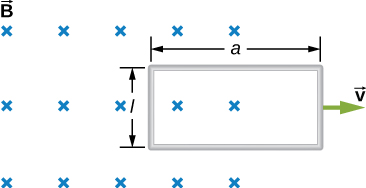
Got questions? Get instant answers now!
Suppose the magnetic field of the preceding problem oscillates with time according to
What then is the emf induced in the loop when its trailing side is a distance
d from the right edge of the magnetic field region?
Got questions? Get instant answers now!
A coil of 1000 turns encloses an area of
. It is rotated in 0.010 s from a position where its plane is perpendicular to Earth’s magnetic field to one where its plane is parallel to the field. If the strength of the field is
what is the average emf induced in the coil?
Got questions? Get instant answers now!
In the circuit shown in the accompanying figure, the rod slides along the conducting rails at a constant velocity
The velocity is in the same plane as the rails and directed at an angle
to them. A uniform magnetic field
is directed out of the page. What is the emf induced in the rod?
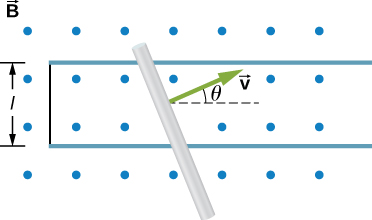
Got questions? Get instant answers now!
The rod shown in the accompanying figure is moving through a uniform magnetic field of strength
with a constant velocity of magnitude
What is the potential difference between the ends of the rod? Which end of the rod is at a higher potential?
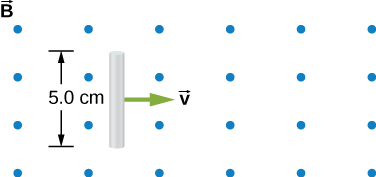
Got questions? Get instant answers now!
A 25-cm rod moves at 5.0 m/s in a plane perpendicular to a magnetic field of strength 0.25 T. The rod, velocity vector, and magnetic field vector are mutually perpendicular, as indicated in the accompanying figure. Calculate (a) the magnetic force on an electron in the rod, (b) the electric field in the rod, and (c) the potential difference between the ends of the rod. (d) What is the speed of the rod if the potential difference is 1.0 V?
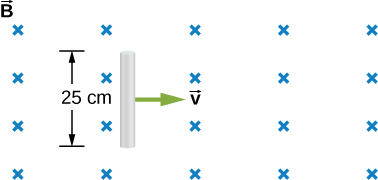
a.
; b. 1.25 V/m; c. 0.3125 V; d. 16 m/s
Got questions? Get instant answers now!
In the accompanying figure, the rails, connecting end piece, and rod all have a resistance per unit length of
The rod moves to the left at
If
everywhere in the region, what is the current in the circuit (a) when
(b) when
Specify also the sense of the current flow.
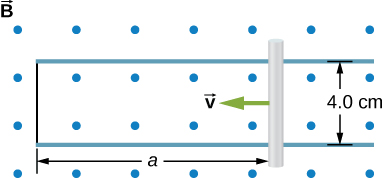
Got questions? Get instant answers now!
The rod shown below moves to the right on essentially zero-resistance rails at a speed of
If
everywhere in the region, what is the current through the
resistor? Does the current circulate clockwise or counterclockwise?
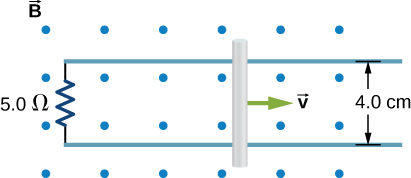
0.018 A, CW as seen in the diagram
Got questions? Get instant answers now!
Shown below is a conducting rod that slides along metal rails. The apparatus is in a uniform magnetic field of strength 0.25 T, which is directly into the page. The rod is pulled to the right at a constant speed of 5.0 m/s by a force
The only significant resistance in the circuit comes from the
resistor shown. (a) What is the emf induced in the circuit? (b) What is the induced current? Does it circulate clockwise or counter clockwise? (c) What is the magnitude of
? (d) What are the power output of
and the power dissipated in the resistor?
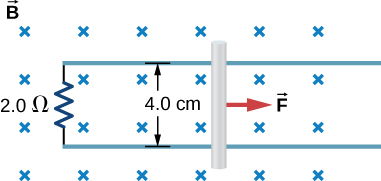
Got questions? Get instant answers now!
Questions & Answers
Three charges q_{1}=+3\mu C, q_{2}=+6\mu C and q_{3}=+8\mu C are located at (2,0)m (0,0)m and (0,3) coordinates respectively. Find the magnitude and direction acted upon q_{2} by the two other charges.Draw the correct graphical illustration of the problem above showing the direction of all forces.
To solve this problem, we need to first find the net force acting on charge q_{2}. The magnitude of the force exerted by q_{1} on q_{2} is given by F=\frac{kq_{1}q_{2}}{r^{2}} where k is the Coulomb constant, q_{1} and q_{2} are the charges of the particles, and r is the distance between them.
Muhammed
What is the direction and net electric force on q_{1}= 5µC located at (0,4)r due to charges q_{2}=7mu located at (0,0)m and q_{3}=3\mu C located at (4,0)m?
what is the change in momentum of a body?
Capacitor is a separation of opposite charges using an insulator of very small dimension between them. Capacitor is used for allowing an AC (alternating current) to pass while a DC (direct current) is blocked.
Gautam
A motor travelling at 72km/m on sighting a stop sign applying the breaks such that under constant deaccelerate in the meters of 50 metres what is the magnitude of the accelerate
What is Thermodynamics
Muordit
velocity can be 72 km/h in question. 72 km/h=20 m/s, v^2=2.a.x , 20^2=2.a.50, a=4 m/s^2.
Mehmet
A boat travels due east at a speed of 40meter per seconds across a river flowing due south at 30meter per seconds. what is the resultant speed of the boat
50 m/s due south east
Someone
which has a higher temperature, 1cup of boiling water or 1teapot of boiling water which can transfer more heat 1cup of boiling water or 1 teapot of boiling water explain your . answer
I believe temperature being an intensive property does not change for any amount of boiling water whereas heat being an extensive property changes with amount/size of the system.
Someone
temperature for any amount of water to boil at ntp is 100⁰C (it is a state function and and intensive property) and it depends both will give same amount of heat because the surface available for heat transfer is greater in case of the kettle as well as the heat stored in it but if you talk.....
Someone
about the amount of heat stored in the system then in that case since the mass of water in the kettle is greater so more energy is required to raise the temperature b/c more molecules of water are present in the kettle
Someone
physics, biology and chemistry
this is my Field
ALIYU
field is a region of space under the influence of some physical properties
Collete
what is ogarnic chemistry
determine the slope giving that 3y+ 2x-14=0
WISDOM
Another formula for Acceleration
pratica A on solution of hydro chloric acid,B is a solution containing 0.5000 mole ofsodium chlorid per dm³,put A in the burret and titrate 20.00 or 25.00cm³ portion of B using melting orange as the indicator. record the deside of your burret tabulate the burret reading and calculate the average volume of acid used?
how do lnternal energy measures
Esrael
Two bodies attract each other electrically. Do they both have to be charged? Answer the same question if the bodies repel one another.
No. According to Isac Newtons law. this two bodies maybe you and the wall beside you.
Attracting depends on the mass och each body and distance between them.
Dlovan
Are you really asking if two bodies have to be charged to be influenced by Coulombs Law?
Robert
like charges repel while unlike charges atttact
Raymond
What is specific heat capacity
Specific heat capacity is a measure of the amount of energy required to raise the temperature of a substance by one degree Celsius (or Kelvin). It is measured in Joules per kilogram per degree Celsius (J/kg°C).
AI-Robot
specific heat capacity is the amount of energy needed to raise the temperature of a substance by one degree Celsius or kelvin
ROKEEB
Source:
OpenStax, University physics volume 2. OpenStax CNX. Oct 06, 2016 Download for free at http://cnx.org/content/col12074/1.3
Google Play and the Google Play logo are trademarks of Google Inc.







